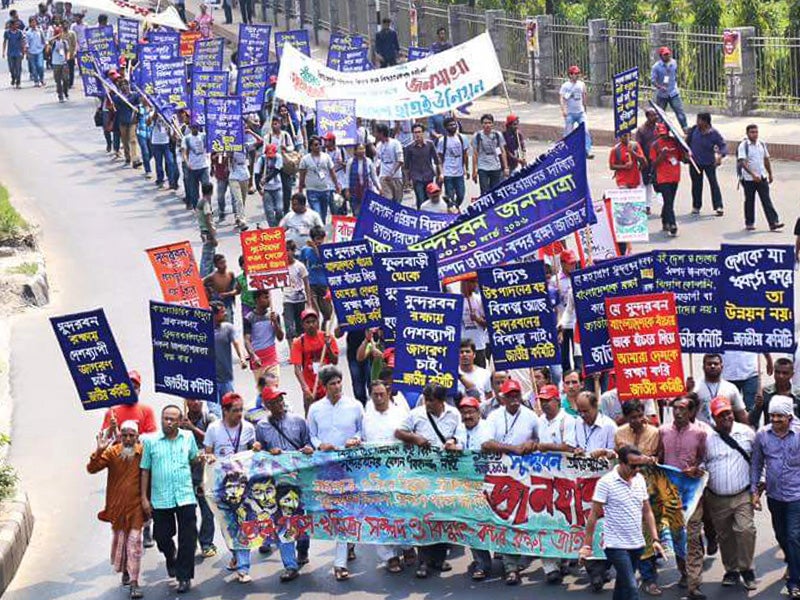‘Long March’ in Bangladesh Urges Protection of Sundarbans Forests from Pollution
More than a thousand concerned citizens marched over 200 miles in scorching heat to protest two planned coal-fired power plants that threaten the Sundarbans World Heritage Site.

This page was published 9 years ago. Find the latest on Earthjustice’s work.
Last weekend, over a thousand Bangladeshis and Indians joined together for a four-day march to demand their governments cancel plans for coal-fired power plants that would threaten the Sundarbans, a vast coastal delta of rivers, mud flats and mangrove islands that spans the boundary between their countries. The Sundarbans is home to endangered Royal Bengal tigers and freshwater dolphins, and is the source of daily food for millions of people. The forest also protects 40 million people from deadly cyclones and tidal floods each year.
The marchers walked more than 200 miles on black asphalt with little shade, in temperatures reaching 97 degrees Fahrenheit. They demanded that the government of Bangladesh cancel the planned Rampal and Orion coal fired power plants, which would emit hundreds of thousands of tons of toxic coal ash and air pollutants, require 36 kilometers of river dredging, and bring constant traffic of coal barges through the Sundarbans.
Environmental groups in Bangladesh, including the National Committee for Saving the Sundarbans, Bangladesh Poribesh Andolon, Nijera Kori and Waterkeepers Bangladesh, recently raised their concerns about the plants to UNESCO’s World Heritage Committee. The groups hope to meet with UN monitors when they arrive in Bangladesh next week to investigate the threat the power plants pose to the Sundarbans World Heritage Site.
“The Sundarbans is not merely a natural wonder in Bangladesh; it is the heritage of every global citizen,” said Sharif Jamil, Joint Secretary of Bangladesh Poribesh Andolon and Coordinator for Waterkeepers Bangladesh. “Thousands marched to protect this unique World Heritage Site from these coal plants, and people around the world are standing in solidarity with us. We demand the Bangladesh government ensure independent and science-based environmental impact assessments for these and any such power plants in the country.”
The government of India is heavily involved in the power plant at Rampal. The day the march began, India’s Export Import bank announced that it will fund the plant. The government of India is jointly financing and managing the plant through its National Thermal Power Corporation (NTPC). An Indian contracting company, Bharat Heavy Electrical (BHEL), recently won the contract to construct the plant.
Several prominent Indian organizations, including the National Fishworkers Forum, All India Union of Forest Working People and Bharat Jan Vigyan Jatha joined the ‘long march’.
“The sensitive riverine ecosystems and the vibrant mangrove forests are not only the best protection from increasingly more violent climate extreme events for nearly 40 million people of south-Bangladesh, but also the only livelihood support for over half-a-million fishers, forest-produce collectors, small farmers, etc.”, said Soumya Dutta, Convenor of the Bharat Jan Vigyan Jatha. “These two coal power plants—if allowed to be built, will be like axing the root of these vibrant life support and safety systems of south-Bangladesh, endangering the lives & livelihoods of millions. Several million tons of coal, lakhs [tens of thousands] of tons of coal dust and ash and enormous amounts of warm water discharge into the river system will devastate the living ecosystems here”.
Other Indian groups, including Conservation Action Trust and the Dakshinbanga Matsyajibi Forum, a fishworker’s union in West Bengal, recently asked the World Heritage Committee to urge the government of India to conduct a transboundary environmental impact assessment of the power plant at Rampal. The assessment would evaluate the impact of the power plants on India’s delicate Sundarbans National Park, also a World Heritage Site.
Earthjustice greatly appreciates the dedication of the Bangladeshi and Indian activists who are marching and organizing to protect this irreplaceable ecosystem.
You can follow the marchers on Twitter at #SaveSundarbans.
The International Program partners with organizations and communities around the world to establish, strengthen, and enforce national and international legal protections for the environment and public health.